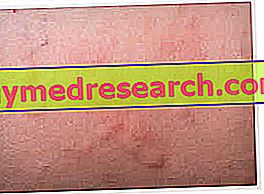Generality
Swollen eyelids are a fairly common condition, an expression of excessive fluid accumulation in the connective tissues around the eyes. At a theoretical level, any inflammatory process that affects the eye area can manifest itself with a palpebral edema.

Symptoms
Knowing the symptoms that accompany the main causes of eyelid swelling can prevent potentially dangerous consequences for eyesight and health. In case of doubt about the etiology of the swollen eyelid, it is still advisable to consult a doctor, especially to prevent the situation from recurring or persisting.
In most cases, swelling, pain and redness of the eyelid are suggestive of an ongoing eye infection. Sometimes, these manifestations can be accompanied by pus secretions in the corner of the eye; the swelling can be unilateral or bilateral and affect the upper and lower eyelids.
The main symptoms associated with swollen eyelids include:
- Eye irritation: red eyes, itching and inflammation of the conjunctiva;
- Pain, particularly when swollen eyelids are caused by an infection;
- Redness of the eyelid;
- Excessive production of tears;
- Burning eyes and feeling of the presence of a foreign body;
- Purulent eye discharge and crusting around the eyes;
- Reduced vision (depending on the extent of the swelling);
- Dryness and peeling of the eyelids;
- Swelling of the face;
- Temperature;
- Loss of eyelashes.
Causes
Swollen eyelids can result from a localized disorder, but also from disorders in and around the orbit or from systemic diseases that cause generalized edema.
| Main causes of swelling of the eyelids | ||
| Causes | Distinguishing features | Diagnostic approach |
| Eyelid disorders | ||
| Local allergic reaction (contact hypersensitivity) |
| Clinical evaluation |
| Blepharitis |
| Clinical evaluation |
| chalazion |
| Clinical evaluation |
| Infectious conjunctivitis |
| Clinical evaluation, usually with fluorescein to rule out Herpes simplex keratoconjunctivitis |
| Type I Herpes Simplex Blepharitis (Ocular Herpes) |
| Clinical evaluation (the condition requires rapid medical intervention) |
| Shingles (shingles) |
| Clinical evaluation |
| stye |
| Clinical evaluation |
| Insect bite |
| Clinical evaluation |
| Disorders in and around the orbit | ||
| Cavernous sinus thrombosis (rare) |
| Computed tomography or magnetic resonance (the condition requires immediate medical intervention) |
| Orbital cellulite |
| CT or MRI (orbital cellulitis can be very serious and deserves immediate medical attention) |
| Periorbital cellulite |
| CT or MRI, to exclude orbital cellulitis |
| Systemic disorders * | ||
| Systemic allergic reaction (angioedema, allergic rhinitis, etc.) |
| Clinical evaluation |
| Generalized edema (systemic processes) |
| Tests for renal, cardiac or hepatic disorders as clinically hypothesized |
| Hyperthyroidism (with Graves ophthalmopathy) |
| Thyroid function tests (TSH and T4) ** |
| Hypothyroidism |
| Thyroid function tests (TSH and T4) |
| tumors |
| Biopsy |
| * The eyelid edema caused by systemic diseases is bilateral and not erythematous. ** T4 = thyroxine, TSH = thyroid stimulating hormone. | ||
Diagnosis
history
The collection of information relating to the patient and his disorder should investigate how long the swelling is present, whether it is unilateral or bilateral, if it was preceded by a trauma or if it is accompanied by other symptoms or diseases. The analysis of symptoms and clinical signs directs the doctor towards possible diagnoses:
- Runny nose, itching, rash and dyspnea (systemic allergic reaction);
- Headache, nasal congestion and purulent nasal discharge (sinusitis);
- Toothache (dental infection);
- Orthopnea and paroxysmal nocturnal dyspnea (heart failure);
- Cold intolerance and changes in skin structure (hypothyroidism);
- Heat intolerance, anxiety, palpitations and weight loss (hyperthyroidism).
The history must also include the search for information relating to:
- Recent injuries or eye surgeries;
- Known cardiac, hepatic, renal or thyroid disorders;
- Allergies and exposure to possible allergens.
Physical examination
Eye inspection should assess the position and appearance of the swelling (erythematous or pale), if it is present on one or both eyelids and if it is painful and / or hot. The examination must above all measure visual acuity and the range of extraocular movements (full or limited). This last examination is important, as any deficits found point towards an orbital or retro-orbital disorder.
The general examination should look for signs of an infection and the symptoms of any possible causal condition. Any injury to the eye or eyelid can be assessed using a slit lamp. Injuries to the numerous small blood vessels and minor traumas around the eye area can cause swelling and bruising, giving the appearance of the "black eye". Facial skin is inspected to assess dryness and swelling (which may suggest hypothyroidism) or look for signs of seborrheic dermatitis.
Interpretation of results
Some results help to distinguish between the categories of disorders.
- The first important distinction is between inflammation or infection on the one hand and allergy or tear disorder on the other. Subsequently, swollen eyelids must be differentiated on the basis of orbital and systemic causes. If edema occurs on a regular basis it could be due to a hypersensitivity reaction to facial cleansers, perfumes, make-up etc. If the swollen eyelids appear with a certain frequency, but in the absence of known allergies, they could be caused by an ocular disorder or a more serious pathology.
- Pain, redness, heat and swelling suggest inflammation or infection.
- The presence of itching suggests an allergic reaction, while the absence suggests renal or cardiac dysfunction.
- The focal swelling of the eyelids, in the absence of other signs, is rarely caused by a serious disorder.
- Signs of inflammation, protrusion of the globe (proptosis), loss of visual acuity and disability of extraocular movements suggest an orbital disorder (for example: orbital cellulitis, cavernous sinus thrombosis). In this case, diagnosis and treatment must proceed as quickly as possible to prevent the disease from progressing.
Other exams
In most cases, the diagnosis can be established clinically and no further investigation is necessary. If orbital cellulitis or cavernous sinus thrombosis is suspected, diagnosis and treatment should proceed as quickly as possible and the patient should be tested by computer tomography or MRI. If cardiac, hepatic, renal or thyroid dysfunction is suspected, with the appropriate laboratory tests and imaging techniques, the function of the potentially involved organ is evaluated.
Treatment
Treatment is always directed at the underlying cause or underlying disease that causes swollen eyelids. Regardless of the etiology, the first useful measure consists in avoiding touching or rubbing the eyes, a gesture that could transfer foreign objects or other bacteria, contributing to worsen the symptoms.
Below are some remedies and possible pharmacological approaches that can help manage this condition:
- Applying a cold pack can help reduce swelling;
- Remove contact lenses and avoid make-up until all symptoms are resolved. The particles of which the tricks are composed can further irritate the eyelids.
- The irritations due to dry eyes can be alleviated by the application of artificial tears or ointment, to favor the movement of the eyelids and avoid the burning sensation.
- To alleviate the symptoms associated with severe allergic reactions, your doctor may prescribe an oral antihistamine and / or corticosteroid eye drops.
- Infections such as Herpes or conjunctivitis, on the other hand, require the prescription of specific antibiotic or antiviral eye drops.
Prevention
- If frequent itching, redness and swelling of the eyelids occur, allergy tests should be considered. If the patient knows the specific allergen to which he is susceptible, he can avoid it or minimize exposure to it. Moreover, it is useful to prefer makeup and other hypoallergenic and fragrance-free cosmetic products.
- In case of hypersensitivity to preservatives, use eye drops that do not have them.
- Contact lens wearers can minimize the risk of infection or irritation of the eyelids by practicing appropriate cleaning techniques and their regular replacement.



